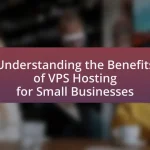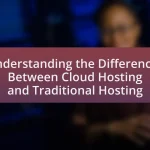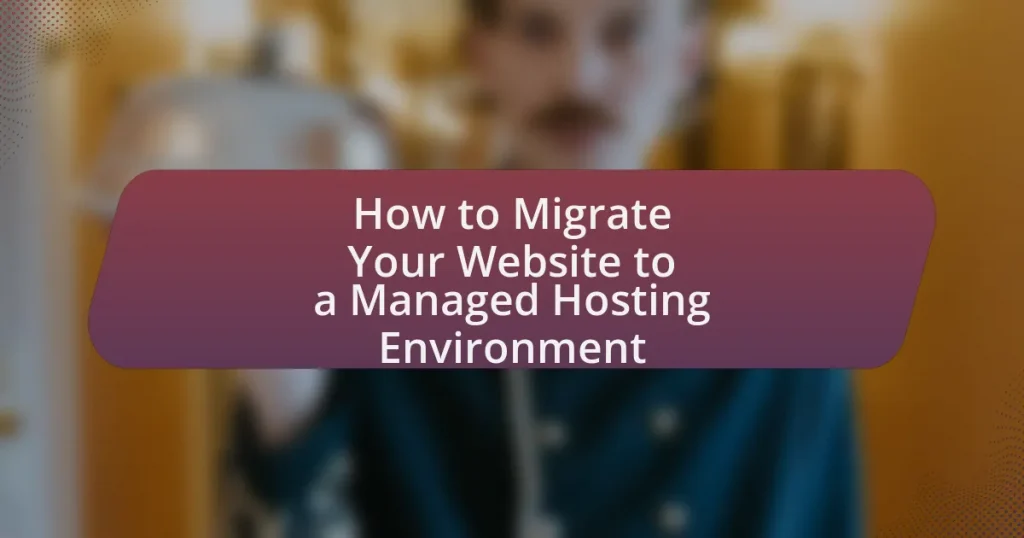A Managed Hosting Environment is a web hosting service where the provider manages server maintenance, security, backups, and software updates, allowing businesses to concentrate on their core operations. This article outlines the differences between managed and traditional hosting, the services included in managed hosting, and the benefits of migration, such as enhanced security and improved performance. It also details the steps for migrating a website, including preparation, execution, and post-migration monitoring, while addressing potential challenges and best practices to ensure a successful transition. Additionally, it provides guidance on selecting the right managed hosting provider and tools to facilitate the migration process.
What is a Managed Hosting Environment?
A Managed Hosting Environment is a type of web hosting service where the provider takes care of the management, maintenance, and support of the server and its infrastructure. This includes tasks such as server setup, monitoring, security, backups, and software updates, allowing businesses to focus on their core activities without worrying about technical issues. Managed hosting typically offers enhanced performance, reliability, and security compared to traditional hosting solutions, as providers often utilize advanced technologies and expertise to optimize server operations.
How does a Managed Hosting Environment differ from traditional hosting?
A Managed Hosting Environment differs from traditional hosting primarily in the level of management and support provided. In a Managed Hosting Environment, the service provider takes care of server management tasks such as maintenance, security, backups, and updates, allowing users to focus on their applications and business needs. In contrast, traditional hosting typically requires users to manage these aspects themselves, which can lead to increased complexity and potential downtime. This distinction is significant as it enhances operational efficiency and reduces the technical burden on users in a Managed Hosting Environment.
What services are typically included in a Managed Hosting Environment?
A Managed Hosting Environment typically includes services such as server management, security monitoring, data backups, software updates, and technical support. These services ensure that the hosting infrastructure is maintained efficiently, providing optimal performance and security for hosted websites. For instance, server management involves configuring and maintaining the server hardware and software, while security monitoring protects against threats and vulnerabilities. Data backups are crucial for data recovery, and regular software updates keep the system secure and up-to-date. Technical support offers assistance with any issues that may arise, ensuring minimal downtime and a smooth user experience.
Why might businesses choose managed hosting over other options?
Businesses might choose managed hosting over other options due to its comprehensive support and optimized performance. Managed hosting providers handle server management, security, and maintenance, allowing businesses to focus on their core operations. This service often includes automatic updates, backups, and technical support, which can significantly reduce downtime and enhance website reliability. According to a study by HostingAdvice, 70% of businesses reported improved performance and security after switching to managed hosting, highlighting its effectiveness in meeting business needs.
What are the key benefits of migrating to a Managed Hosting Environment?
Migrating to a Managed Hosting Environment offers several key benefits, including enhanced security, improved performance, and expert support. Enhanced security is achieved through regular updates, firewalls, and monitoring, which protect against cyber threats. Improved performance results from optimized server configurations and dedicated resources, leading to faster load times and better user experiences. Expert support is available 24/7, ensuring that technical issues are resolved quickly, minimizing downtime. These benefits collectively contribute to a more reliable and efficient hosting solution for businesses.
How does managed hosting improve website performance?
Managed hosting improves website performance by providing dedicated resources and optimized server configurations tailored to specific website needs. This environment minimizes downtime and enhances loading speeds, as managed hosting providers often utilize high-performance hardware and advanced caching techniques. Additionally, managed hosting includes proactive monitoring and maintenance, which ensures that any potential issues are addressed promptly, further contributing to consistent performance. Studies have shown that websites on managed hosting can experience up to 50% faster load times compared to shared hosting solutions, significantly impacting user experience and search engine rankings.
What security advantages does a Managed Hosting Environment provide?
A Managed Hosting Environment provides enhanced security through dedicated resources, regular updates, and expert monitoring. These environments typically include firewalls, intrusion detection systems, and data encryption, which protect against unauthorized access and data breaches. Additionally, managed hosting providers often implement strict compliance measures, such as GDPR and PCI DSS, ensuring that sensitive information is handled according to industry standards. This comprehensive approach to security minimizes vulnerabilities and reduces the risk of cyber threats, making it a reliable choice for businesses prioritizing data protection.
What steps are involved in migrating your website to a Managed Hosting Environment?
The steps involved in migrating your website to a Managed Hosting Environment include planning the migration, selecting a managed hosting provider, backing up your existing website, transferring files and databases, configuring the new environment, testing the website functionality, and finally updating the DNS settings.
Planning the migration involves assessing your current website’s needs and determining the best managed hosting solution. Selecting a managed hosting provider requires evaluating options based on performance, support, and features. Backing up your existing website ensures that you have a copy of all files and data in case of issues during migration. Transferring files and databases involves moving your website content to the new server, often using FTP or migration tools. Configuring the new environment includes setting up server settings, security measures, and any necessary software. Testing the website functionality is crucial to ensure everything works as expected before going live. Finally, updating the DNS settings directs traffic to the new hosting environment, completing the migration process.
How do you prepare for the migration process?
To prepare for the migration process, conduct a comprehensive assessment of your current website environment and create a detailed migration plan. This involves evaluating your existing hosting setup, identifying all website components such as databases, files, and applications, and determining the necessary resources and configurations needed in the new managed hosting environment. Additionally, ensure that you have a complete backup of your website data to prevent any loss during the migration. According to a study by the Content Management Institute, 70% of website migrations fail due to inadequate planning, highlighting the importance of thorough preparation.
What data and files need to be backed up before migration?
Before migration, it is essential to back up website files, databases, and configuration settings. Website files include all HTML, CSS, JavaScript, images, and any other media files that constitute the site’s content. Databases, such as MySQL or PostgreSQL, must be exported to ensure that all data, including user information and content, is preserved. Configuration settings, which may include server settings, application configurations, and any custom scripts, should also be documented and backed up. This comprehensive backup ensures that all critical components of the website are secured and can be restored if needed during or after the migration process.
How can you assess your current hosting needs before migration?
To assess your current hosting needs before migration, evaluate your website’s traffic, resource usage, and performance requirements. Analyzing metrics such as average monthly visitors, peak traffic times, and server load will help determine the necessary bandwidth, storage, and processing power. Additionally, consider your website’s growth projections and any specific applications or features that may require additional resources. For instance, if your site experiences seasonal spikes in traffic, you may need a hosting solution that can scale accordingly.
What are the technical steps to execute the migration?
The technical steps to execute the migration include planning, backing up data, setting up the new environment, transferring files, updating DNS settings, and testing the new site. First, planning involves assessing the current website and determining the requirements for the new managed hosting environment. Next, backing up data ensures that all website files, databases, and configurations are securely saved. Setting up the new environment requires configuring the server settings and installing necessary software. Transferring files involves moving the backed-up data to the new server, which can be done via FTP or other transfer methods. Updating DNS settings directs traffic to the new hosting environment, and finally, testing the new site ensures that all functionalities work correctly before fully switching over. These steps are essential for a successful migration to minimize downtime and data loss.
How do you choose the right Managed Hosting provider?
To choose the right Managed Hosting provider, evaluate their performance, support, scalability, and security features. Performance is critical; look for providers with high uptime guarantees, typically above 99.9%, and fast server response times. Support should be 24/7 and include multiple channels like chat, email, and phone, ensuring assistance is readily available. Scalability is essential for future growth; select a provider that allows easy upgrades to accommodate increased traffic or resource needs. Security features must include regular backups, SSL certificates, and proactive monitoring to protect your data. These criteria are validated by industry standards, where top providers consistently meet or exceed these benchmarks, ensuring reliability and efficiency in managed hosting services.
What tools can assist in the migration process?
Tools that can assist in the migration process include website migration plugins, cloud migration services, and content management system (CMS) tools. Website migration plugins, such as Duplicator and All-in-One WP Migration, facilitate the transfer of files and databases for WordPress sites. Cloud migration services like AWS Migration Hub and Google Cloud Migrate provide comprehensive solutions for moving applications and data to cloud environments. Additionally, CMS tools, including Joomla and Drupal migration modules, streamline the process for specific platforms. These tools are widely recognized for their effectiveness in simplifying and automating the migration process, ensuring minimal downtime and data integrity.
What challenges might you face during the migration process?
During the migration process to a managed hosting environment, you might face challenges such as data loss, downtime, and compatibility issues. Data loss can occur if backups are not properly managed or if there are errors during the transfer, leading to missing files or corrupted data. Downtime is another significant challenge, as the transition may require your website to be temporarily offline, affecting user access and potentially leading to lost revenue. Compatibility issues may arise if the new hosting environment does not support certain applications or configurations used in the previous setup, which can disrupt website functionality. These challenges highlight the importance of thorough planning and testing before initiating the migration process.
How can you troubleshoot common migration issues?
To troubleshoot common migration issues, first identify the specific problem, such as broken links, missing files, or database connection errors. Next, verify that all files have been transferred correctly and that the database has been imported without errors. Check the configuration settings, including DNS records and server settings, to ensure they align with the new environment. Additionally, review error logs for any server-side issues that may indicate the source of the problem. For instance, a 404 error may suggest that files were not properly migrated, while a 500 error could point to server misconfigurations. By systematically addressing these areas, you can effectively resolve migration issues.
What are the most frequent problems encountered during migration?
The most frequent problems encountered during migration include data loss, downtime, and compatibility issues. Data loss can occur due to improper backups or transfer errors, leading to missing files or corrupted data. Downtime often results from misconfigurations or server issues, which can disrupt website accessibility during the migration process. Compatibility issues arise when the existing website software does not align with the new hosting environment, potentially causing functionality problems. These challenges are commonly reported in migration case studies, highlighting the importance of thorough planning and testing to mitigate risks.
How can you ensure minimal downtime during the migration?
To ensure minimal downtime during migration, implement a phased migration strategy. This involves transferring data and services in stages rather than all at once, allowing for testing and adjustments at each phase. For instance, using a staging environment to replicate the live site can help identify potential issues before the final switch. Additionally, employing DNS management techniques, such as lowering the TTL (Time to Live) settings prior to migration, can facilitate quicker updates to DNS records, reducing the time users experience downtime. Studies show that phased migrations can reduce downtime by up to 90%, as they allow for real-time troubleshooting and adjustments.
What post-migration steps should you take to ensure success?
To ensure success after migrating your website to a managed hosting environment, conduct thorough testing of all website functionalities. This includes checking links, forms, and interactive elements to confirm they operate correctly in the new environment. Additionally, monitor website performance metrics such as load times and uptime to identify any issues that may arise post-migration. Implementing a backup strategy is crucial; regular backups safeguard against data loss. Finally, update your DNS settings to point to the new hosting provider, ensuring that visitors can access your site without interruption. These steps are essential for maintaining website integrity and performance after migration.
How do you monitor your website’s performance after migration?
To monitor your website’s performance after migration, utilize tools such as Google Analytics, Google Search Console, and performance monitoring software like GTmetrix or Pingdom. These tools provide insights into traffic patterns, page load times, and overall site health. For instance, Google Analytics tracks user behavior and traffic sources, while Google Search Console helps identify indexing issues and search performance. Performance monitoring tools like GTmetrix offer detailed reports on page speed and performance metrics, allowing for immediate identification of any issues post-migration. Regularly reviewing these metrics ensures that any performance degradation is promptly addressed, maintaining optimal user experience and search engine rankings.
What ongoing maintenance is required in a Managed Hosting Environment?
Ongoing maintenance in a Managed Hosting Environment includes regular software updates, security monitoring, performance optimization, and backup management. Software updates ensure that the operating system and applications are up-to-date, reducing vulnerabilities. Security monitoring involves continuous assessment of the environment for potential threats, utilizing tools that can detect and respond to intrusions. Performance optimization focuses on resource allocation and load balancing to maintain efficient operation. Backup management ensures that data is regularly backed up and can be restored in case of failure, adhering to best practices for data integrity and availability. These maintenance tasks are essential for ensuring reliability, security, and optimal performance in a managed hosting setup.
What best practices should you follow when migrating to a Managed Hosting Environment?
When migrating to a Managed Hosting Environment, it is essential to conduct thorough planning and assessment of your current infrastructure. This involves evaluating your website’s requirements, including bandwidth, storage, and security needs, to ensure the new environment can accommodate them effectively. Additionally, creating a detailed migration plan that outlines timelines, responsibilities, and potential risks is crucial for a smooth transition.
Testing the new environment before the actual migration is another best practice; this allows you to identify any issues and ensure compatibility with your applications. Furthermore, it is important to back up all data and configurations to prevent data loss during the migration process.
Communicating with your managed hosting provider is vital, as they can offer support and guidance tailored to your specific needs. Finally, after migration, monitoring the performance and security of your website in the new environment will help you address any issues promptly and optimize your setup for better performance.
How can you create a migration checklist to streamline the process?
To create a migration checklist that streamlines the process, begin by identifying key tasks involved in the migration, such as inventorying current assets, selecting a managed hosting provider, and planning the migration timeline. Each task should be broken down into actionable steps, including data backup, DNS updates, and testing the new environment.
For instance, inventorying current assets involves listing all website components, such as databases, files, and applications, ensuring nothing is overlooked. Selecting a managed hosting provider requires evaluating options based on performance, support, and scalability. Planning the migration timeline should include milestones for each phase of the migration, allowing for adjustments as needed.
Additionally, incorporating a review phase after migration ensures that all functionalities are working correctly and that the website performs as expected in the new environment. This structured approach not only enhances organization but also minimizes the risk of errors during the migration process.
What resources are available for further assistance during migration?
Resources available for further assistance during migration include comprehensive guides, customer support from hosting providers, and community forums. Comprehensive guides often detail step-by-step processes for migration, ensuring users understand each phase. Customer support from hosting providers typically offers direct assistance, addressing specific issues or questions that arise during the migration process. Community forums provide a platform for users to share experiences and solutions, fostering a collaborative environment for troubleshooting. These resources collectively enhance the migration experience by providing essential information and support.










